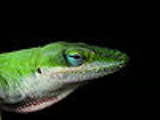
Carolina anole
Encyclopedia
The Carolina anole is an arboreal lizard
found primarily in the southeastern United States
and some Caribbean
islands. Other common names include the green anole, American anole and red-throated anole. It is sometimes referred to as the American chameleon due to its color-changing abilities; however, many lizards are capable of this, and anoles are not true chameleon
s.
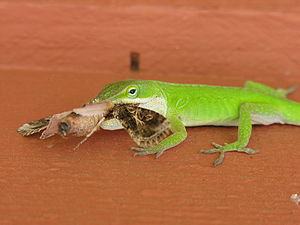 This species is native to North America
This species is native to North America
, where it is found mainly in the southeastern parts of the continent. Anoles are most abundant on the Atlantic Coastal Plain
s in North Carolina
, South Carolina
, Florida
and Georgia
, and the Gulf Coastal Plain
in Texas
. The species has been introduced into Hawaii
and the Ogasawara Islands
.
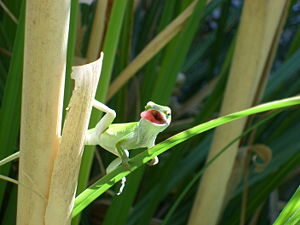 Anoles are often territorial
Anoles are often territorial
. In fact some have even been witnessed fighting their own reflection in mirrored glass. Stress in an anole can be identified by several symptoms. These symptoms include a constant shade of brown and a persistent black semicircle behind their eyes and chronic lethargy.
Like many lizards, anoles display autotomy
of the tail to escape predation.
Anoles are curious creatures. A healthy lizard usually has a good awareness of its surroundings. The males are very territorial and will fight other males to defend its territory. Many times the other male will be an extremely invasive Cuban Brown Anole.
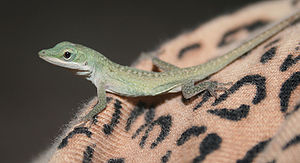 The typical breeding season for green anoles starts from as early as April and ends to as late as August and lasts even occasionally into September. It is during this time that the most brilliant displays of these creatures can be seen, as the males must court the females with their elaborate displays of extending their brightly colored dewlaps while bobbing up and down, almost doing a dance for her while she runs in temptation from the male. The pursuit will continue until the two successfully mate. Usually, when the female is ready to mate, she may let the male simply "catch" her and he will thus grasp a hold of a fold of her skin above her neck area, or she will bow her head before him and simply "let" him take his grasp. At this point, the male will position his tail underneath the female's near her vent and the mating ritual will take place.
The typical breeding season for green anoles starts from as early as April and ends to as late as August and lasts even occasionally into September. It is during this time that the most brilliant displays of these creatures can be seen, as the males must court the females with their elaborate displays of extending their brightly colored dewlaps while bobbing up and down, almost doing a dance for her while she runs in temptation from the male. The pursuit will continue until the two successfully mate. Usually, when the female is ready to mate, she may let the male simply "catch" her and he will thus grasp a hold of a fold of her skin above her neck area, or she will bow her head before him and simply "let" him take his grasp. At this point, the male will position his tail underneath the female's near her vent and the mating ritual will take place.
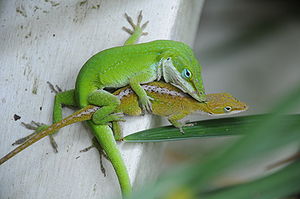 After a 2–4 week span following mating, the female will lay her first clutch of eggs, usually ranging from 1–2 in the first clutch. She will continue to lay eggs during the season until a total of 10 or so eggs have been produced. When it comes time for her to lay her eggs, she will bury them in the soft soils or compost
After a 2–4 week span following mating, the female will lay her first clutch of eggs, usually ranging from 1–2 in the first clutch. She will continue to lay eggs during the season until a total of 10 or so eggs have been produced. When it comes time for her to lay her eggs, she will bury them in the soft soils or compost
nearby, and after that she no longer takes any care for it. The egg(s) are/is left alone to incubate by the light of the sun and if successful will hatch in 30–45 or so days.
The hatchlings must fend for themselves, anoles are by nature solitary animals since birth and are not cared for by the mother or the father. The young hatchlings must be wary of other adult anoles in the area as well as larger reptiles and mammals who could eat them.
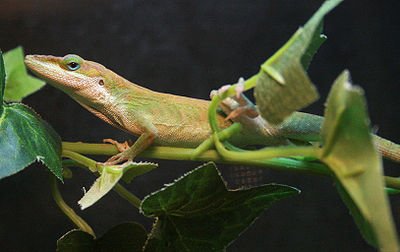 The typical coloration for a green anole ranges from the richest and brightest of greens to the darkest of browns, with little variation in between. The color spectrum is a resultant of three layers of pigment cells or chromatophore
The typical coloration for a green anole ranges from the richest and brightest of greens to the darkest of browns, with little variation in between. The color spectrum is a resultant of three layers of pigment cells or chromatophore
s: the xanthophores, responsible for the yellow pigmentation; cyanophores, responsible for the blue pigmentation, and melanophores, responsible for the brown and black pigmentation when the anole is cold or stressed.
There are a few exceptions which are caused when a lack in one of the pigment
gene
s occurs. These color mutation
s are also called phases. The rare blue-phased green anole lacks xanthophores which results in a blue, rather red, often baby or pastel blue, anole. These specimens have become a recent popularity in the trade market. When the anole is completely lacking xanthophores it is said to be axanthic and the animal will have a completely pastel or baby-blue hue. They are extremely rare—usually produced in 1 out of every 20,000 individual anoles in the wild. Another 'phase' is the yellow-phased green anole, which lacks cyanophores. Colonies of these rare color-phased anoles have been reported, but anoles with these color mutations rarely live for long, since the green color provides camouflage for hunting down prey as well as hiding from predators.
Turning brown indicates distress. Some catchers prefer not to catch a Carolina anole that turns brown, so as to avoid causing undue stress to the animal.
reptile for genomics
by the National Human Genome Research Institute
(NHGRI) genome sequencing
program. It was selected because of the ease and low cost of laboratory breeding and evolutionary value of the diversity of the genus. Before its genome was published, only mammals and 3 bird species had been sequenced among amniote
s. The draft genome sequence is 1.78 Gb (can be compared to ~3 Gb mammalian and ~1 Gb avian genomes), of which 30% is mobile elements such as LINEs, and contains an initially predicted 17,472 protein-coding genes and 2,924 RNA genes.
(Anolis sagrei) is a highly invasive
lizard in the same genus
as the Carolina anole (Anolis carolinensis). It is native to Cuba
and several other Caribbean
islands, but has been introduced
to Florida
and has spread through the state. It has seriously depleted the population of carolina anoles throughout its range, due to competition for food and habitat. Some think that these lizards spread when they laid their eggs in potted plants at nurseries, which were then shipped throughout the state.
Many people that keep green anoles as pets feed them mealworms,grubs, and maggots.
Lizard
Lizards are a widespread group of squamate reptiles, with nearly 3800 species, ranging across all continents except Antarctica as well as most oceanic island chains...
found primarily in the southeastern United States
Southeastern United States
The Southeastern United States, colloquially referred to as the Southeast, is the eastern portion of the Southern United States. It is one of the most populous regions in the United States of America....
and some Caribbean
Caribbean
The Caribbean is a crescent-shaped group of islands more than 2,000 miles long separating the Gulf of Mexico and the Caribbean Sea, to the west and south, from the Atlantic Ocean, to the east and north...
islands. Other common names include the green anole, American anole and red-throated anole. It is sometimes referred to as the American chameleon due to its color-changing abilities; however, many lizards are capable of this, and anoles are not true chameleon
Chameleon
Chameleons are a distinctive and highly specialized clade of lizards. They are distinguished by their parrot-like zygodactylous feet, their separately mobile and stereoscopic eyes, their very long, highly modified, and rapidly extrudable tongues, their swaying gait, the possession by many of a...
s.
Distribution

North America
North America is a continent wholly within the Northern Hemisphere and almost wholly within the Western Hemisphere. It is also considered a northern subcontinent of the Americas...
, where it is found mainly in the southeastern parts of the continent. Anoles are most abundant on the Atlantic Coastal Plain
Atlantic Coastal Plain
The Atlantic coastal plain has both low elevation and low relief, but it is also a relatively flat landform extending from the New York Bight southward to a Georgia/Florida section of the Eastern Continental Divide, which demarcates the plain from the ACF River Basin in the Gulf Coastal Plain to...
s in North Carolina
North Carolina
North Carolina is a state located in the southeastern United States. The state borders South Carolina and Georgia to the south, Tennessee to the west and Virginia to the north. North Carolina contains 100 counties. Its capital is Raleigh, and its largest city is Charlotte...
, South Carolina
South Carolina
South Carolina is a state in the Deep South of the United States that borders Georgia to the south, North Carolina to the north, and the Atlantic Ocean to the east. Originally part of the Province of Carolina, the Province of South Carolina was one of the 13 colonies that declared independence...
, Florida
Florida
Florida is a state in the southeastern United States, located on the nation's Atlantic and Gulf coasts. It is bordered to the west by the Gulf of Mexico, to the north by Alabama and Georgia and to the east by the Atlantic Ocean. With a population of 18,801,310 as measured by the 2010 census, it...
and Georgia
Georgia (U.S. state)
Georgia is a state located in the southeastern United States. It was established in 1732, the last of the original Thirteen Colonies. The state is named after King George II of Great Britain. Georgia was the fourth state to ratify the United States Constitution, on January 2, 1788...
, and the Gulf Coastal Plain
Gulf Coastal Plain
The Gulf Coastal Plain extends around the Gulf of Mexico in the Southern United States and eastern Mexico.The plain reaches from the western Florida Panhandle, the southwestern two thirds of Alabama, over most of Mississippi, some of western Tennessee and Kentucky, southwest Arkansas, the Florida...
in Texas
Texas
Texas is the second largest U.S. state by both area and population, and the largest state by area in the contiguous United States.The name, based on the Caddo word "Tejas" meaning "friends" or "allies", was applied by the Spanish to the Caddo themselves and to the region of their settlement in...
. The species has been introduced into Hawaii
Hawaii
Hawaii is the newest of the 50 U.S. states , and is the only U.S. state made up entirely of islands. It is the northernmost island group in Polynesia, occupying most of an archipelago in the central Pacific Ocean, southwest of the continental United States, southeast of Japan, and northeast of...
and the Ogasawara Islands
Ogasawara Islands
The Bonin Islands, known in Japan as the are an archipelago of over 30 subtropical and tropical islands, some directly south of Tokyo, Japan. Administratively, they are part of Ogasawara Municipality of Ogasawara Subprefecture, Tokyo...
.
Behavior

Territory (animal)
In ethology the term territory refers to any sociographical area that an animal of a particular species consistently defends against conspecifics...
. In fact some have even been witnessed fighting their own reflection in mirrored glass. Stress in an anole can be identified by several symptoms. These symptoms include a constant shade of brown and a persistent black semicircle behind their eyes and chronic lethargy.
Like many lizards, anoles display autotomy
Autotomy
Autotomy or self amputation is the act whereby an animal severs one or more of its own appendages, usually as a self-defense mechanism designed to elude a predator's grasp...
of the tail to escape predation.
Anoles are curious creatures. A healthy lizard usually has a good awareness of its surroundings. The males are very territorial and will fight other males to defend its territory. Many times the other male will be an extremely invasive Cuban Brown Anole.
Reproduction


Compost
Compost is organic matter that has been decomposed and recycled as a fertilizer and soil amendment. Compost is a key ingredient in organic farming. At its most essential, the process of composting requires simply piling up waste outdoors and waiting for the materials to break down from anywhere...
nearby, and after that she no longer takes any care for it. The egg(s) are/is left alone to incubate by the light of the sun and if successful will hatch in 30–45 or so days.
The hatchlings must fend for themselves, anoles are by nature solitary animals since birth and are not cared for by the mother or the father. The young hatchlings must be wary of other adult anoles in the area as well as larger reptiles and mammals who could eat them.
Coloration and color morphs

Chromatophore
Chromatophores are pigment-containing and light-reflecting cells found in amphibians, fish, reptiles, crustaceans, and cephalopods. They are largely responsible for generating skin and eye colour in cold-blooded animals and are generated in the neural crest during embryonic development...
s: the xanthophores, responsible for the yellow pigmentation; cyanophores, responsible for the blue pigmentation, and melanophores, responsible for the brown and black pigmentation when the anole is cold or stressed.
There are a few exceptions which are caused when a lack in one of the pigment
Biological pigment
Biological pigments, also known simply as pigments or biochromes are substances produced by living organisms that have a color resulting from selective color absorption. Biological pigments include plant pigments and flower pigments...
gene
Gene
A gene is a molecular unit of heredity of a living organism. It is a name given to some stretches of DNA and RNA that code for a type of protein or for an RNA chain that has a function in the organism. Living beings depend on genes, as they specify all proteins and functional RNA chains...
s occurs. These color mutation
Mutation
In molecular biology and genetics, mutations are changes in a genomic sequence: the DNA sequence of a cell's genome or the DNA or RNA sequence of a virus. They can be defined as sudden and spontaneous changes in the cell. Mutations are caused by radiation, viruses, transposons and mutagenic...
s are also called phases. The rare blue-phased green anole lacks xanthophores which results in a blue, rather red, often baby or pastel blue, anole. These specimens have become a recent popularity in the trade market. When the anole is completely lacking xanthophores it is said to be axanthic and the animal will have a completely pastel or baby-blue hue. They are extremely rare—usually produced in 1 out of every 20,000 individual anoles in the wild. Another 'phase' is the yellow-phased green anole, which lacks cyanophores. Colonies of these rare color-phased anoles have been reported, but anoles with these color mutations rarely live for long, since the green color provides camouflage for hunting down prey as well as hiding from predators.
Turning brown indicates distress. Some catchers prefer not to catch a Carolina anole that turns brown, so as to avoid causing undue stress to the animal.
Genomics
This species has been chosen as a modelModel organism
A model organism is a non-human species that is extensively studied to understand particular biological phenomena, with the expectation that discoveries made in the organism model will provide insight into the workings of other organisms. Model organisms are in vivo models and are widely used to...
reptile for genomics
Genomics
Genomics is a discipline in genetics concerning the study of the genomes of organisms. The field includes intensive efforts to determine the entire DNA sequence of organisms and fine-scale genetic mapping efforts. The field also includes studies of intragenomic phenomena such as heterosis,...
by the National Human Genome Research Institute
National Human Genome Research Institute
The National Human Genome Research Institute is a division of the National Institutes of Health, located in Bethesda, Maryland.NHGRI began as the National Center for Human Genome Research , which was established in 1989 to carry out the role of the NIH in the International Human Genome Project...
(NHGRI) genome sequencing
Full genome sequencing
Full genome sequencing , also known as whole genome sequencing , complete genome sequencing, or entire genome sequencing, is a laboratory process that determines the complete DNA sequence of an organism's genome at a single time...
program. It was selected because of the ease and low cost of laboratory breeding and evolutionary value of the diversity of the genus. Before its genome was published, only mammals and 3 bird species had been sequenced among amniote
Amniote
The amniotes are a group of tetrapods that have a terrestrially adapted egg. They include synapsids and sauropsids , as well as their fossil ancestors. Amniote embryos, whether laid as eggs or carried by the female, are protected and aided by several extensive membranes...
s. The draft genome sequence is 1.78 Gb (can be compared to ~3 Gb mammalian and ~1 Gb avian genomes), of which 30% is mobile elements such as LINEs, and contains an initially predicted 17,472 protein-coding genes and 2,924 RNA genes.
Brown anole
The Brown AnoleBrown Anole
The Brown Anole is a lizard native to Cuba and the Bahamas. It has been widely introduced elsewhere, and is now found in Florida and as far north as southern Georgia, Texas, Taiwan, Hawaii, Southern California, and other Caribbean islands.This species is highly invasive...
(Anolis sagrei) is a highly invasive
Invasive species
"Invasive species", or invasive exotics, is a nomenclature term and categorization phrase used for flora and fauna, and for specific restoration-preservation processes in native habitats, with several definitions....
lizard in the same genus
Anolis
Anolis is a genus of lizards belonging to the family Polychrotidae. With nearly 400 species, Anolis represents the world's most species rich amniote genus. Several species of Anolis are occasionally ascribed to the genus Norops, but the validity of the Norops genus is not widely accepted...
as the Carolina anole (Anolis carolinensis). It is native to Cuba
Cuba
The Republic of Cuba is an island nation in the Caribbean. The nation of Cuba consists of the main island of Cuba, the Isla de la Juventud, and several archipelagos. Havana is the largest city in Cuba and the country's capital. Santiago de Cuba is the second largest city...
and several other Caribbean
Caribbean
The Caribbean is a crescent-shaped group of islands more than 2,000 miles long separating the Gulf of Mexico and the Caribbean Sea, to the west and south, from the Atlantic Ocean, to the east and north...
islands, but has been introduced
Introduced species
An introduced species — or neozoon, alien, exotic, non-indigenous, or non-native species, or simply an introduction, is a species living outside its indigenous or native distributional range, and has arrived in an ecosystem or plant community by human activity, either deliberate or accidental...
to Florida
Florida
Florida is a state in the southeastern United States, located on the nation's Atlantic and Gulf coasts. It is bordered to the west by the Gulf of Mexico, to the north by Alabama and Georgia and to the east by the Atlantic Ocean. With a population of 18,801,310 as measured by the 2010 census, it...
and has spread through the state. It has seriously depleted the population of carolina anoles throughout its range, due to competition for food and habitat. Some think that these lizards spread when they laid their eggs in potted plants at nurseries, which were then shipped throughout the state.
Diet
The anole's diet consists of small insects such as the cricket and the grasshopper. It may also eat grasses. Crickets are a good food for them as well as moths.Many people that keep green anoles as pets feed them mealworms,grubs, and maggots.

